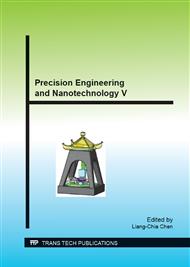[1]
E.M. Kopalinsky, and P.L.B. Oxley, Size Effects in Metal Removal Processes, Mechanical Properties at High Rates of Strain Oxford; UK; (1984) 389-396.
Google Scholar
[2]
M., Shaw, The size effect in metal cutting. Sadhana, The Indian Academy of Sciences 28 (2003)875-896.
DOI: 10.1007/bf02703319
Google Scholar
[3]
R.L. Hecker, I.M. Ramoneda, and , S.Y. Liang, Analysis of Wheel Topography and Grit Force for Grinding Process Modeling. Journal of Manufacturing Processes 5 (2003) 13-23.
DOI: 10.1016/s1526-6125(03)70036-x
Google Scholar
[4]
M.C. Shaw, Principles of abrasive processing. Clarendon Press (1996).
Google Scholar
[5]
J. Verkerk, and J. Peters, Final report concerning CIRP cooperative work on the characterization of grinding wheel topography. Ann CIRP. 26(1977)385-395.
Google Scholar
[6]
G. Srihari, and G.K. Lal, Mechanics of vertical surface grinding. Journal of Materials Processing Technology 44(1994) 14-28.
DOI: 10.1016/0924-0136(94)90034-5
Google Scholar
[7]
S. Malkin, Grinding Technology: Theory and Applications of machining with abrasives. Halsted Press, Chichester; New York. ( 1989).
Google Scholar
[8]
P.K. Basuray, B.K. Misra, and G.K. Lal, Transition from ploughing to cutting during machining with blunt tools. Wear 43(1977) 341-349.
DOI: 10.1016/0043-1648(77)90130-2
Google Scholar
[9]
K. Liu, and X.P. Li, , Modeling of ductile cutting of tungsten carbide. Trans. NAMRI/SME 29(2001)251-258.
Google Scholar
[10]
S.M. Son, H.S. Lim, and Ahn, J.H., Effects of the friction coefficient on the minimum cutting thickness in micro cutting. International Journal of Machine Tools and Manufacture 45(4-5)(2005) 529-535.
DOI: 10.1016/j.ijmachtools.2004.09.001
Google Scholar
[11]
M.E. Merchant, Mechanics of metal cutting process, and type 2 chip, Journal of Applied Physics 16(1945) 318-324. www. fivesgroup. com.
Google Scholar


